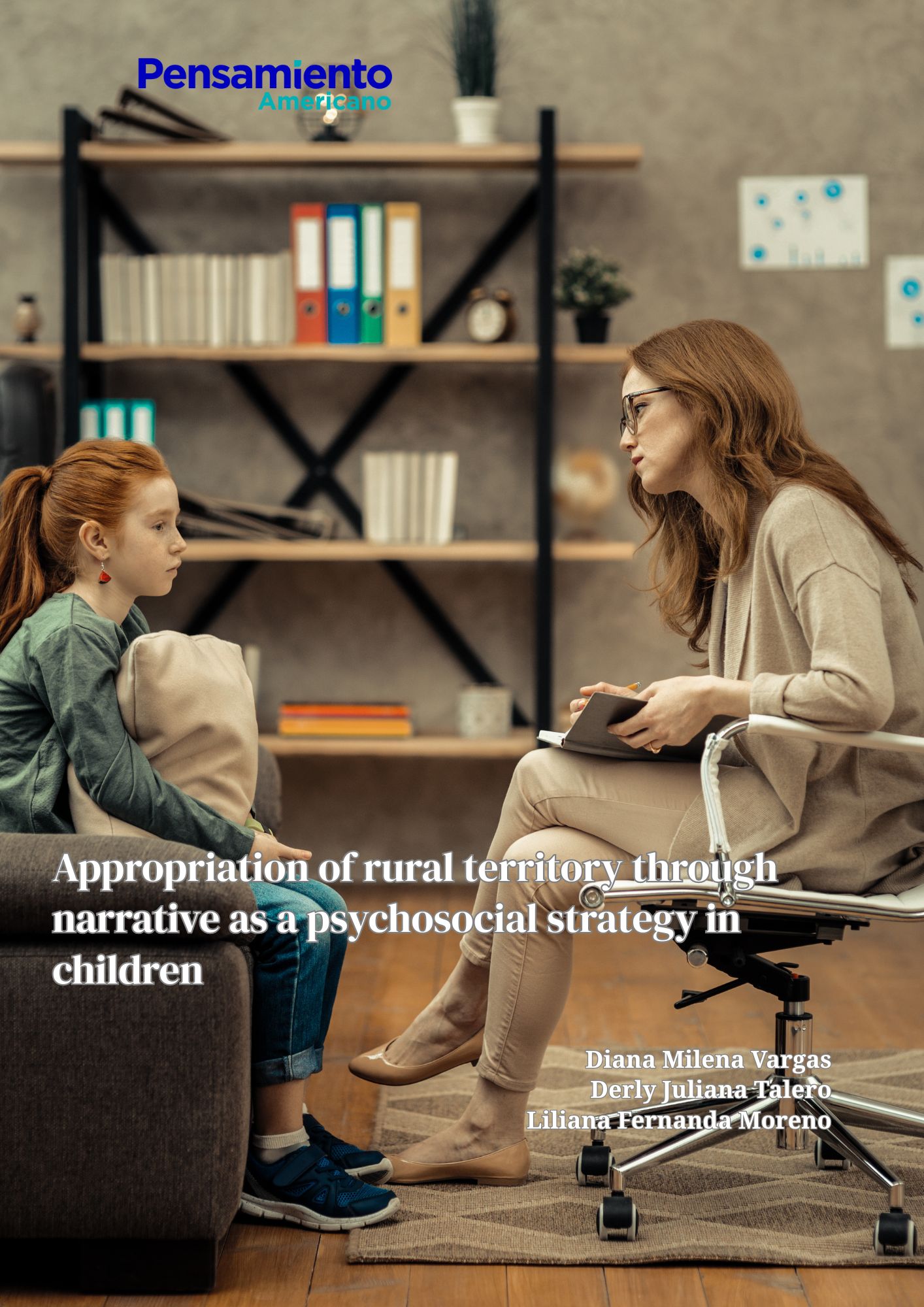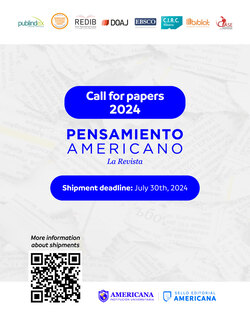Appropriation of rural territory through narrative as a psychosocial strategy in children
DOI:
https://doi.org/10.21803/penamer.18.38.946Keywords:
appropriation of territory, narratives, sense of community, territories, culture, identity. , childhood, psychosocial strategy, transmedia narrativesAbstract
- i) introduction: the territory can be constructed as a symbolic and affective space in which bonds, practices, and collective memories become integrating elements of community dynamics. Childhood, despite often being rendered invisible, actively participates in the production of meaning about its environment, especially through narrative. ii) objective: this article analyzes the appropriation of territory in rural childhood and the role of narratives in this process. iii) methodology: a qualitative research approach was employed to capture participants’ perceptions of their sense of belonging. A phenomenological design was proposed, enabling an exploration of each participant’s experiences and providing a meaningful contribution to the construction of subjectivity within the rural context. The analysis was carried out through category coding with the support of Atlas.ti software. iv) results: the findings show that narratives facilitate the re-signification of the environment, expressing community bonds and strengthening dimensions of the psychological sense of community, such as membership and emotional connection. v) conclusions: narrative as a psychosocial strategy operates through transformation, which reinforces the symbolic appropriation of territory and promotes collective empowerment from childhood.
Downloads
References
Boyd B. (2018). The evolution of stories: from mimesis to language, from fact to fiction. Wiley interdisciplinary reviews. Cognitive science, 9(1), e1444. https://doi.org/10.1002/wcs.1444
Bruner, J. (1992). The narrative construction of reality. In H. Beilin & P. B. Pufall (Eds.), Piaget's theory: Prospects and possibilities (pp. 229–248). Lawrence Erlbaum Associates, Inc.
Castaño-Aguirre, C. A., Baracaldo-Silva, P., Bravo-Arcos, A. M., Arbeláez-Caro, J.-S., Ocampo-Fernández, J., y Pineda-López, O.-L. (2021). Territory and Territorialization: A Look at the Emotional Link to the Inhabited Place Through Social Cartography. Revista Guillermo de Ockham, 19(2), 201–217. https://doi.org/10.21500/22563202.5296
Colín-Mar, I. (2022). Narrativas comunitarias en la construcción del imaginario social. Aproximaciones al relato como recurso vivo de la memoria colectiva. (2022). Comunicación, 46, 92-107. https://doi.org/10.18566/comunica.n46.a06
González, R. (2000). Mito y archivo: una teoría de la narrativa latinoamericana. México: Fondo de Cultura Económica.
Grajales, G. (2010). El conocimiento tradicional y el concepto de territorio. Núcleo de Estudios, Pesquisas e Projectos de Reforma Agrária, 1-12. https://www2.fct.unesp.br/nera/artigodomes/2artigodomes_2010.pdf
Haesbaert, R. (2013). Del mito de la desterritorialización a la multiterritorialidad. Cultura y representaciones sociales, 8(15), 9-42. http://www.scielo.org.mx/scielo.php?script=sci_arttext&pid=S2007-81102013000200001&lng=es&tlng=es.
Hall, S. (Ed.). (1997). Representation: Cultural representations and signifying practices. Sage Publications, Inc; Open University Press.
Halbwachs M. (2004). La memoria colectiva. Traducción de Inés Sancho-Arroyo. Zaragoza. Prensas Universitarias de Zaragoza. 2004. https://books.google.com.co/books?hl=es&lr=&id=ZN-hDAAAQBAJ&oi=fnd&pg=PA7&dq=Maurice+Halbwachs+memoria+colectiva+1925&ots=DDd3HmyQTw&sig=bKsGORWUl7W3jnHkomQAlTO2LYI#v=onepage&q=Maurice%20Halbwachs%20memoria%20colectiva%201925&f=false
Hart, R. A. (1997). Children's participation: The theory and practice of involving young citizens in community development and environmental care. UNICEF & Earthscan.
Jenkins, H. (2003, enero 15). Transmedia storytelling. MIT Technology Review https://www.technologyreview.com/2003/01/15/234540/transmedia-storytelling/
Martínez-Rodríguez, L. A., Martínez-Correal, M. L., Hernández-Cortes, M. C., & Barcelo-Kahrs, A. J. (2024). Conflicto y paz: narrativas infantiles. Via Inveniendi Et Iudicandi, 19(1), 105-125. https://doi.org/10.15332/19090528.10099
Maya-Jariego, I. (2023). Múltiples niveles ecológicos en el estudio del sentido psicológico de comunidad con el barrio de residencia. Apuntes de Psicología, 41(3), 131-135. https://doi.org/10.55414/ap.v41i3.1564
McMillan, D., & Chavis, D. (1986). Sense of community: A definition and theory. Journal of Community Psychology, 14(1), 6-23. https://www.researchgate.net/publication/235356904_Sense_of_Community_A_Definition_and_Theory
Marchant, M. (2020). Memoria, territorio y experiencia. Reflexiones a partir del pensamiento de W. Benjamín. Hermenéutica Intercultural, (34), 91–113. https://doi.org/10.29344/07196504.34.2567
Meza-Rueda, J. L. (2008). Narración y pedagogía: elementos epistemológicos, antecedentes y desarrollos de la pedagogía narrativa. Actualidades Pedagógicas, (51), 59-72.
Páez-Martínez, R. M. (2011). Narración mítica: necesario tejido espiritual en la formación de los niños. Revista Iberoamericana De Educación, 54(5), 1–12. https://doi.org/10.35362/rie5451650
Porto-Gonçalves, C. W. (2021). Outros horizontes para a geogra7a pela vida, pela dignidade e pelo território. En D. Cattaneo, M. Argenta Câmara y R. Ferreira da Silveira (Ed.), Geografias das R-existências (pp. 19-38). Monstro dos Mares. https://biblioteca.clacso.edu.ar/Brasil/anpege/20210820093307/Geografias-r-esistencia.pdf
Reyes-Guarnizo, A. B. (2020). Comprensión del territorio para la construcción de apropiación e identidad en el municipio de Soacha. Revista de Arquitectura (Bogotá), 22(1), 44–57. https://doi.org/10.14718/RevArq.2020.2651
Rizzini, I., & Butler, U. M. (2003). Life Trajectories of Children and Adolescents Living on the Streets of Rio de Janeiro. Children, Youth and Environments, 13(1), 182–201. http://www.jstor.org/stable/10.7721/chilyoutenvi.13.1.0182
Salazar-Escorcia, L. S. (2020). Investigación cualitativa: Una respuesta a las investigaciones sociales educativas. Cienciamatria, 6(11), 101-110. https://doi.org/10.35381/cm. v6i11.327
Sánchez, J. (2006). Narrativa Audiovisual. Barcelona: Eureka Media.
Schank, R. (1995). Tell Me a Story: Narrative and Intelligence. Northwestern University
Scolari, C. (2013). Narrativas transmedia: cuando todos los medios cuentan. Barcelona: Deusto.
Trujillo-Vanegas, C. (2022). El territorio para los niños y las niñas. Entramado vincular para la comprensión, construcción y cuidado de la vida. Corporación Universitaria Remington. https://www.researchgate.net/publication/366722252_El_territorio_para_los_ninos_y_las_ninas_Entramado_vincular_para_la_comprension_construccion_y_cuidado_de_la_vida
Wahren, J. (2012). Movimientos Sociales, y territorios en disputa. Experiencias de trabajo y autonomía de la Unión de Trabajadores Desocupados de Gral. Mosconi, Salta. Trabajo y Sociedad, 19, 133-147. https://www.redalyc.org/pdf/3873/387334691008.pdf
Ytreberg, E. (2009). Extended liveness and eventfulness in multi-platform reality formats. New Media & Society, 11(4), 467-485. https://doi.org/10.1177/1461444809102955.

Downloads
Published
Issue
Section
License
Copyright (c) 2025 Pensamiento Americano

This work is licensed under a Creative Commons Attribution-NonCommercial-NoDerivatives 4.0 International License.
The author or authors of an article accepted for publication in the Journal Pensamiento Americano will transfer all of the patrimonial rights to the American University Corporation free of charge, within which are included: the right to edit, publish, reproduce and distribute both print media as digital, in addition to include in article in international indexes and / or databases, likewise, the Editorial Seal is authorized to use the images, tables and / or any graphic material presented in the article for the design of covers or posters from the same magazine. By assuming the patrimonial rights of the article, it may not be partially or totally reproduced in any printed or digital media without its express permission.
AUTHORITY ASPECTS
For the Pensamiento Americano Journal, all the authors of an article have made substantial contributions to the research and the manuscript, and they share the responsibility when the article presents errors, fraud in some way or violations of copyright.
After submitting an article, the journal does not accept the addition, deletion or change in the order of the authors, in addition we reserve the right to release the article when it has been submitted to the journal and under no circumstances will American Thought accept the article. withdrawal of an article during any phase of the editorial process





